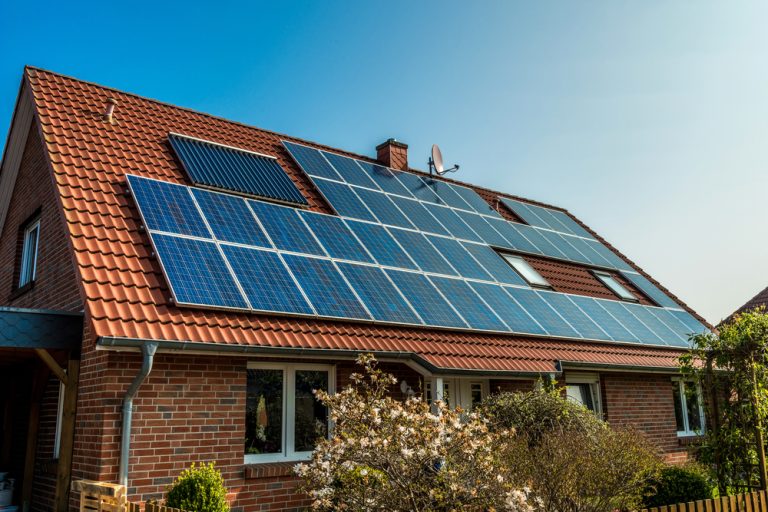How Do Solar Panels Work On A House?
Homeowners in New Mexico are looking for alternative energy sources. The most apparent and readily available is solar energy. With so many sunny days in New Mexico, it is essential to take advantage of it.
Solar panels are an excellent option for cutting down energy costs, reducing environmental impact, and offering other benefits like supporting local businesses and contributing to energy independence.
Are you looking to install solar panels in your New Mexico home? Poulin Solar Pro is a premier company in the New Mexico Solar Energy industry, helping people in the area embrace solar technology for many years. In this post, we will discuss the nitty-gritty science behind the use of solar. Let’s dive in!
The Process of Generating Electricity
Solar panels convert the sun’s energy into usable electricity for domestic and commercial use. The photovoltaic (PV) solar panels have numerous solar cells packed in glass packaging. The solar cells act as semiconductors using their positive and negative layers to create an electric field, like in a battery.
The PV solar panels generate Direct Current (DC) electricity. It creates a situation where all electrons flow in a single direction in a circuit. For example, the electron moves from the negative side through the lamp to power a light bulb and returns through the positive end.
The most preferred electricity in the house is Alternating Current (AC) electricity. It is where electrons move back and forth periodically to reverse their direction. Generators produce AC by spinning a coil of wire next to a magnet.
AC electric is the most common electrical grid used to power thousands of homes. However, solar panels only create DC electricity. To turn the DC to AC, you will need an inverter.
What Does a Solar Inverter Do?
A solar inverter converts DC electricity to AC electricity. It acts as the brain of the systems by further offering ground fault protection and system stats with voltage and current on DC and AC circuits, maximum power point tracking, and energy production.
The inverters that have dominated the solar industry are central inverters. The recent shift to micro-inverters has also revolutionized the PV industry significantly. With micro-inverters, you can optimize the energy output for every solar panel and make it perform to its maximum potential.
When using a central inverter, an issue with one solar panel can drag the whole solar array. With micro-inverters, each solar panel can perform on its own efficiently even when one has a problem.
How Does a Solar Panel System Work?
The functioning of a solar panel system is relatively easy to understand. First, sunlight enters the solar panel on the roof or open space. The panel converts the sun’s energy into DC, which flows into the inverter and converts into AC.
The power from the inverter can power all your electrical components. The power is clean, making it more efficient and affordable to get energy for all domestic uses.
The Science of How Solar Panels Work: Solar Cells and the Photovoltaic Effect
Discovering everything you ought to know about going solar and the science behind its usage is now easy with the free solar report from Poulin Solar Pro. Grab yours today to get the step-by-step blueprint for going solar. You can also sign for an email listing to receive a monthly customized report.
Additional Important Parts of Solar Panels
Apart from solar cells, a typical solar system will have several essential parts for its functioning. The panels have a glass casing for maximized durability and protection of the cells inside.
Below the glass, the exterior is an insulation layer protecting the solar panel from heat dissipation and humidity. The insulation is crucial to ensure no excess temperature of the cells that can minimize efficiency resulting in lower performance.
All solar panels will also feature an anti-reflective coating to increase sunlight absorption and offer cells maximum sunlight exposure.
What Is A Grid-Tied Solar Panel System?
After installing solar panels, most of your electricity will likely come directly from the systems as long as they are of the proper size. But remember, the solar panels can’t convert energy at night or when there is no sun shining. Your home will remain connected to the local electrical utility grid to access power. In this case, the solar system is grid-tied.
It’s the typical scenario for most homeowners unless you have a solar-plus-storage system. Solar panels will not constantly generate power unless there is enough sunlight to convert it to electricity.
Time to Make the Move to Solar Energy with Poulin Solar Pro
You can save on utility costs and boost your home energy use by going solar. Visit our Albuquerque, NM or Santa Fe, NM locations, or get in touch with us at Poulin Solar Pro.

